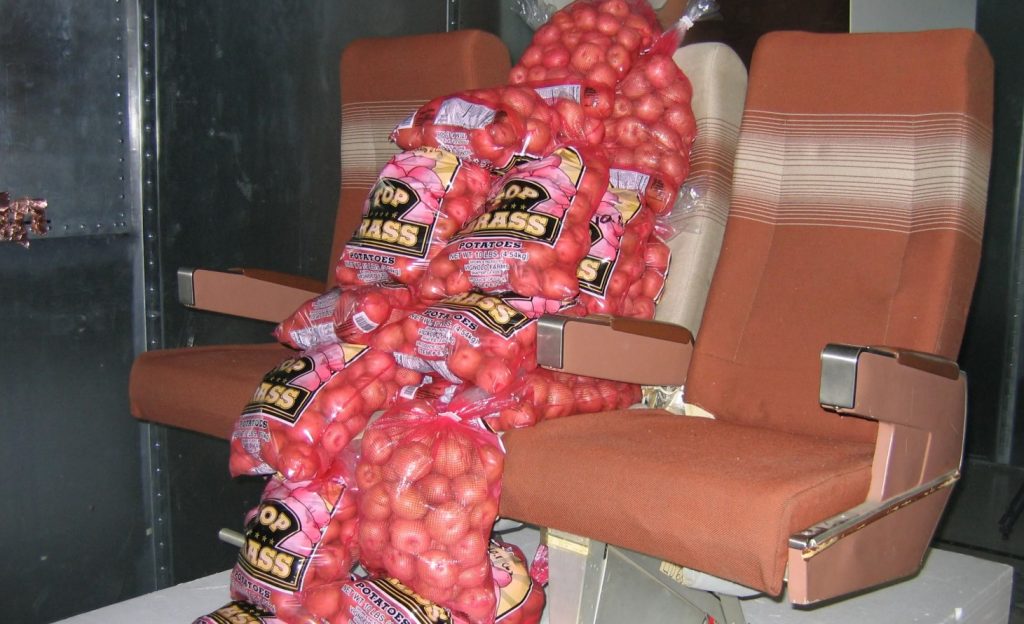Can a Flying Potato Read This Email?
If you’ve been on an airplane recently, you probably know that — even though you’re 30,000 feet above ground — you can still send an email or a text. That’s because, increasingly, airlines are offering in-flight Wi-Fi. It’s a good idea, too: for business travelers, connectivity means you can work on the plane, and for vacationers (and particularly those with young kids), Wi-Fi can be a cure for boredom. But getting this technology on planes wasn’t so simple. Putting aside the work needed to actually get an Internet signal on a plane going 500 miles per hour while five or so miles above ground, airliners also need to make sure the signal doesn’t interfere with the gizmos that pilots use to actually fly the plane. Figuring out how to get Wi-Fi throughout the cabin of a plane too a lot of math, science, and testing.
And it also took about ten tons of potatoes.
Starting in 2006, airline manufacturer Boeing knew that making Wi-Fi consistently reliable on its planes was a big issue — consumers demanded being able to get online and the airlines that bought planes from Boeing were responsive to that. After getting planes connected, though, consumers still complained about spotty connectivity. So Boeing got to testing.
Getting a clear Wi-Fi signal throughout an empty Boeing jet turned out to be easy; the problem occurred when you filled it with passengers. All those people were blocking the signal. Boeing had some ideas for how to fix it, but testing was difficult — it’s expensive to take a plane full of people up in the air for hours at a time just to test your upload and download speeds. And asking people to sit still for hours at a time isn’t a great idea, either.
Potatoes became the solution. As seen in a photo, below, bags of potatoes can be stacked in an airplane seat to roughly model the size and shape of an adult human.

But that’s not all. Potatoes also mimic another aspect of human bodies: how we interact with radio waves. As Phys.org explains, “It turns out that potatoes—because of their water content and chemistry—absorb and reflect radio wave signals much the same way as the human body does, making them suitable substitutes for airline passengers.” The project, called Synthetic Personnel Using Dialectic Substitution, or SPUDS (heh) cut tests that previously took two weeks down to only a few hours, according to a video from Boeing. (That video contains footage of a plane full of potatoes, if you want to see this in action.)
Using the SPUDS system, Boeing was able to significantly limit the amount of Wi-Fi dead spots on their planes, all without involving real people until the final testing round. And the potatoes didn’t go to waste, either; according to CNN, they were donated to a food pantry.
Bonus fact: Burger chain Five Guys operates in all 50 U.S. states and about two dozen other nations. But they don’t get the potatoes for their French fries from just anywhere. As the company shared on Facebook, “Most of our potatoes come from Idaho and are grown north of the 42nd parallel. Why? They grow during the day when it’s warm and stop at night when the temp cools. This creates denser higher quality potatoes which cost a bit more than their southern counterparts, but make better fries.” (The word “most” there is because, as Mashed explains, “for two months of the year, when the growing season dictates, they switch to Washington State potatoes.”) All of Idaho and Washington, as seen in this map, are entirely above the 42nd parallel.
From the Archives: Regal Potatoes: How a king tricked his subjects into eating potatoes.
